Overview
Navigating the VA rating process for diabetes benefits can be challenging for veterans, and we understand that. This article offers essential insights into the complexities you may face. It's crucial to recognize the differences between Type 1 and Type 2 diabetes, as well as the impact of secondary health conditions on your claims.
To enhance your chances of receiving the benefits you deserve, understanding the necessary documentation is key. We want to support you in this journey, ensuring you have the information you need to advocate for yourself effectively.
Remember, you are not alone in this process. Many veterans share similar experiences, and together, we can navigate these complexities. We encourage you to explore the resources available and reach out for assistance. Your well-being is important, and we are here to help you every step of the way.
Introduction
Navigating the complexities of the VA rating system for diabetes can feel overwhelming for veterans. You are not alone in this journey; nearly 25% of those receiving care from the VA are affected by this condition. Understanding the nuances of diabetes ratings, including the distinctions between Type 1 and Type 2 diabetes, is vital for former service members seeking the benefits they deserve.
We understand that with recent policy changes and the integration of AI technology to streamline the application process, many veterans are left wondering: how can they best leverage these resources to ensure a successful claim? This article delves into nine key insights designed to empower you to navigate the VA rating process with confidence and clarity.
Turnout: Streamline Your VA Diabetes Rating Process
Turnout is transforming how former service members navigate the VA rating for diabetes process. By utilizing AI technology, we simplify applications and claims, making the journey less overwhelming. This innovative approach not only streamlines the process but also ensures that veterans receive timely support and guidance.
We understand that navigating the VA system can feel daunting. By concentrating on compassion and efficiency, Turnout empowers former service members to take charge of their benefits journey. Veterans have expressed appreciation for this support, noting that it enhances their ability to navigate the VA system. As one experienced individual remarked, "The support I received made the process feel less daunting and more achievable."
With diabetes impacting almost 25% of the VA’s patient population, consumer advocacy organizations like Turnout play an essential role in assisting former military personnel in obtaining the VA rating for diabetes and the benefits they deserve. The integration of AI technology allows for quicker processing times and more accurate assessments, ultimately leading to better outcomes for those seeking diabetes-related benefits.
By addressing specific criteria for the VA rating for diabetes, which depend on blood sugar control, complications, and daily life impact, Turnout clarifies the path to obtaining VA ratings. Importantly, Turnout is not a law firm and does not provide legal representation; instead, it utilizes trained advocates to assist veterans effectively. Remember, you are not alone in this journey—we're here to help.
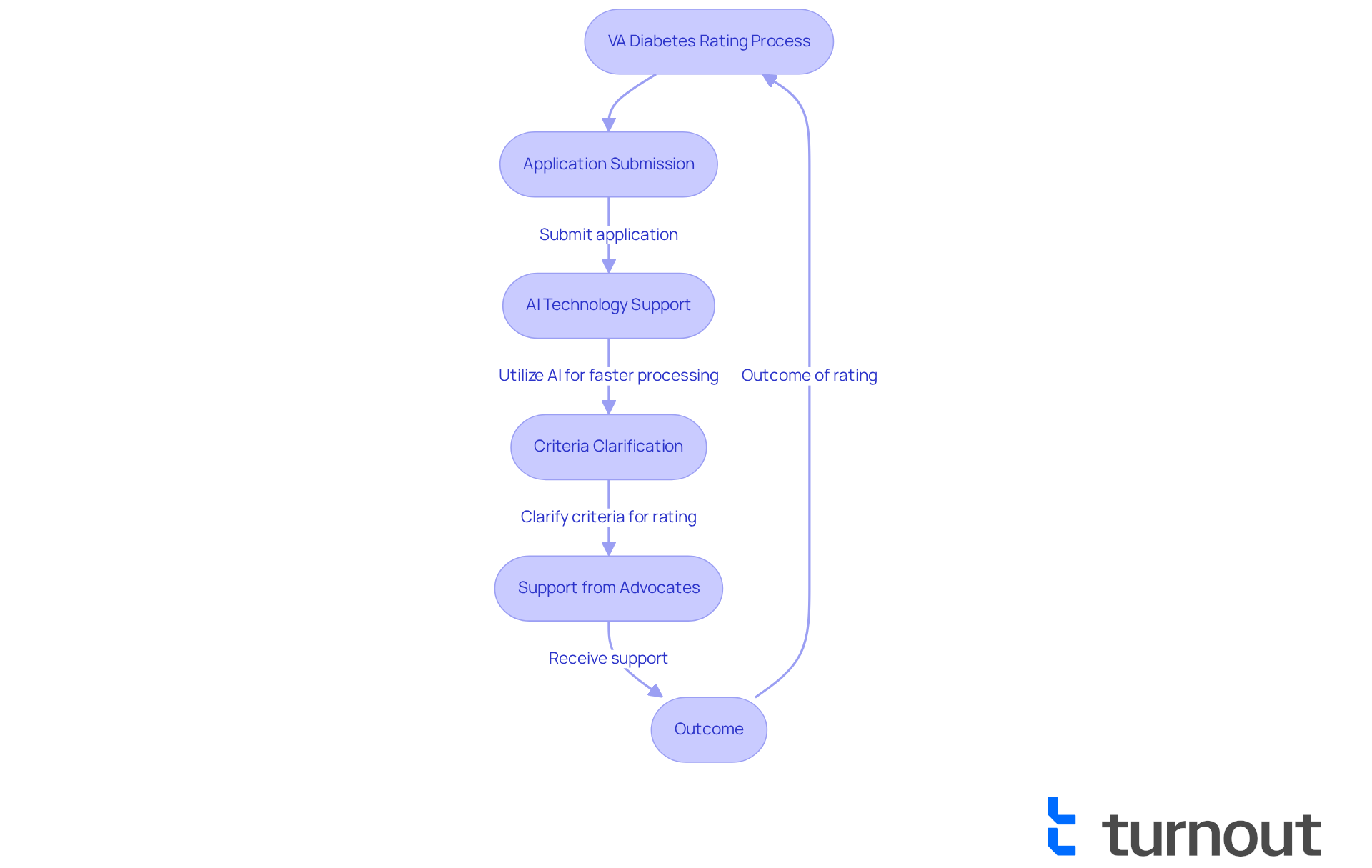
Types of Diabetes Recognized by the VA: What You Should Know
The VA recognizes two primary types of blood sugar disorders: Type 1 and Type 2. Type 1, often diagnosed in childhood, occurs when the body cannot produce insulin. In contrast, Type 2, which is more common among adults, typically arises from lifestyle factors and can sometimes be managed through diet and exercise. Understanding your specific type of condition is crucial, as it significantly impacts your eligibility for benefits and the VA rating for diabetes that you might receive.
For former military personnel, Type 2 blood sugar issues can hold particular importance, especially for those exposed to Agent Orange during their service. This exposure can create a presumptive connection, allowing veterans to qualify for benefits without needing to demonstrate the condition's link to their military service. Nearly 25% of veterans receiving VA care have diabetes, a rate more than double that of the general population. This highlights the necessity of understanding these distinctions.
Healthcare professionals emphasize the importance of precise documentation when submitting requests. Medical records, personal statements, and lab results are vital for validating claims and securing appropriate VA evaluations. For instance, individuals with Type 2 blood sugar issues may be assigned a VA rating for diabetes based on their management needs, with higher ratings requiring more intensive treatment, such as insulin therapy or specialized diets.
We understand that navigating the application process can be challenging for those with military experience. Many veterans express frustration with the VA's bureaucracy, particularly regarding claims related to hypertension and other health issues. As one veteran shared, despite being diagnosed with hypertension and a blood sugar condition, he received a 0% rating due to not meeting specific blood pressure criteria. This illustrates the complexities involved in obtaining benefits.
In summary, grasping the differences between Type 1 and Type 2 conditions is essential for veterans seeking VA benefits. These distinctions can profoundly affect the outcome of claims and the support available to those managing these conditions. Remember, you are not alone in this journey, and we are here to help.
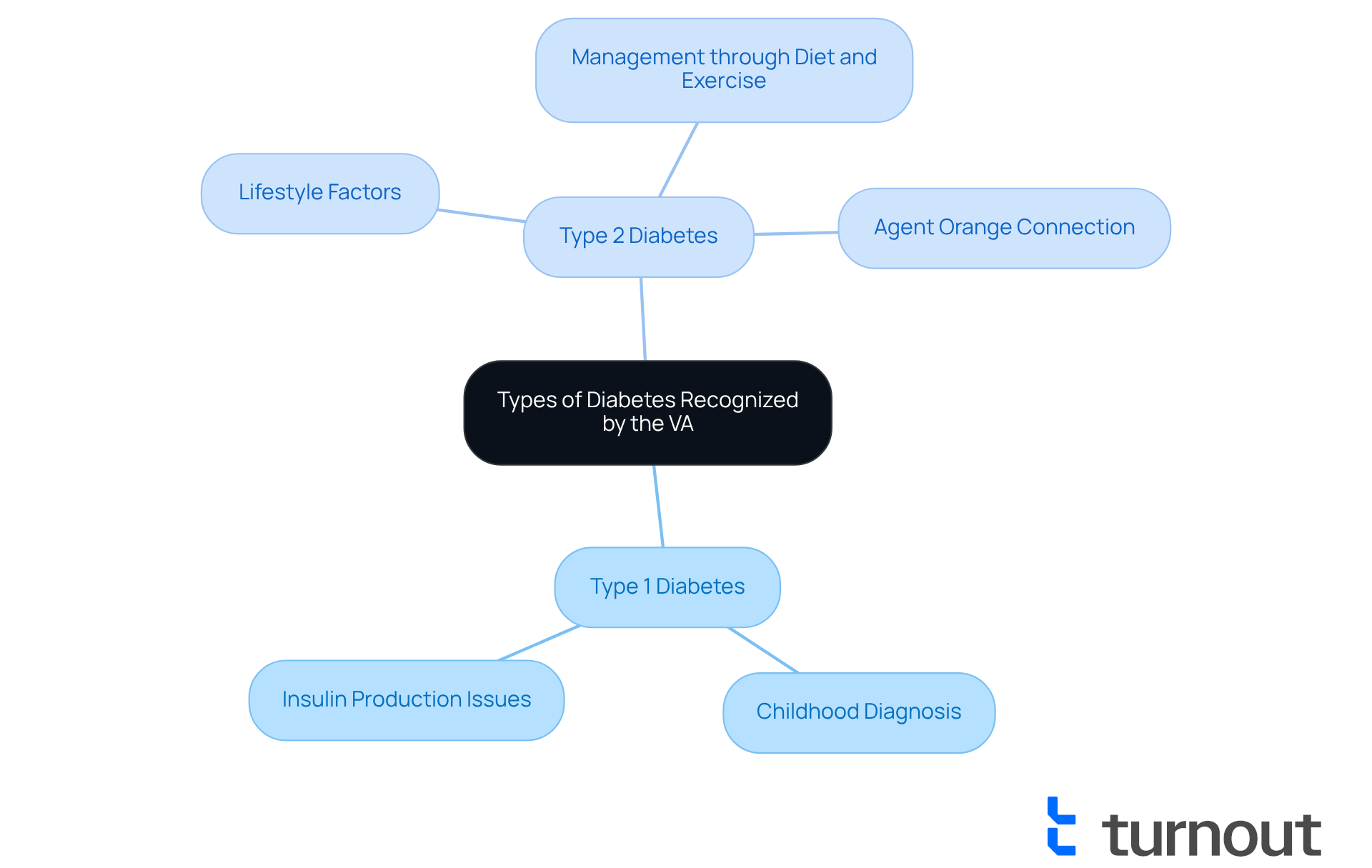
VA Rating Levels for Diabetes: A Comprehensive Breakdown
The VA rating for diabetes includes level assessments determined by the seriousness of the condition and its complications, with evaluations ranging from 0% to 100%. Higher percentages reflect more severe impacts on daily functioning. For instance, a 20% VA rating for diabetes is commonly given to individuals who need insulin or oral medication, while a 100% VA rating for diabetes is allocated for those facing serious complications that greatly diminish their quality of life.
We understand that navigating these evaluations can be challenging. Veterans have shared their experiences, emphasizing the significance of comprehending these assessments. One individual remarked, 'The assistance I received made me feel like family, and it was essential in managing my claim.' Another emphasized, 'Your blood sugar assessment may change if your condition deteriorates or your treatment needs escalate.' This highlights the importance for former service members to keep detailed medical records and remain aware of their health condition.
As we look ahead to 2025, the VA continues to assess health evaluations based on treatment needs. Many individuals receive assessments of 10%, 20%, 40%, 60%, or even 100%, depending on their specific circumstances. Understanding the VA rating for diabetes is crucial for former service members to effectively advocate for the benefits they deserve. Remember, you are not alone in this journey; we’re here to help.
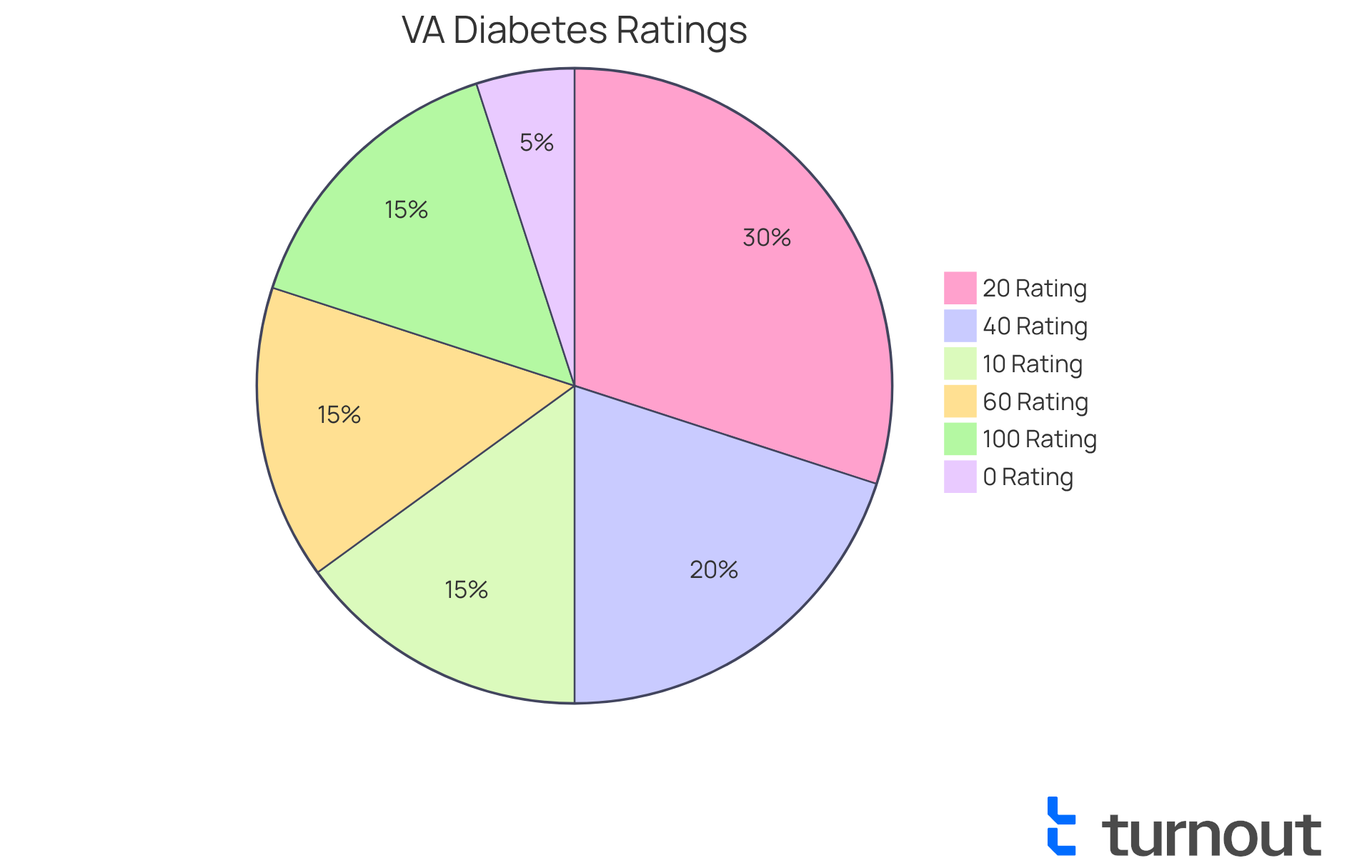
Impact of Secondary Conditions on VA Diabetes Ratings
Health issues like neuropathy, heart disease, and kidney problems can deeply affect your VA rating for diabetes related to blood sugar management. We understand that these comorbidities can complicate your overall health assessment as a former service member. For instance, if you are managing blood sugar issues alongside peripheral neuropathy, you may qualify for an elevated assessment due to the combined impact on your daily activities.
It's important to note that roughly one in three adults with high blood sugar develops kidney disease. If you have diabetic kidney problems, a decline in your kidney function may lead to an enhanced VA rating for diabetes, which can significantly influence your disability compensation.
We encourage veterans to meticulously document all associated health concerns when submitting requests. This thorough approach can greatly affect your overall disability evaluation. Medical professionals emphasize that secondary conditions can heighten the severity of assessments for VA rating for diabetes. As Brian Reese points out, 'requiring more than one daily injection of insulin, a restricted diet, and regulation of activities with episodes of ketoacidosis or hypoglycemic reactions necessitating at least three hospitalizations per year can lead to a 100% rating.'
Additionally, including a nexus letter can strengthen claims for secondary conditions, establishing a vital connection between your disease and its complications. Recognizing these links, especially with upcoming changes in 2025, can empower you to optimize your benefits and navigate the complexities of the VA system with greater ease. Remember, you are not alone in this journey—we're here to help.
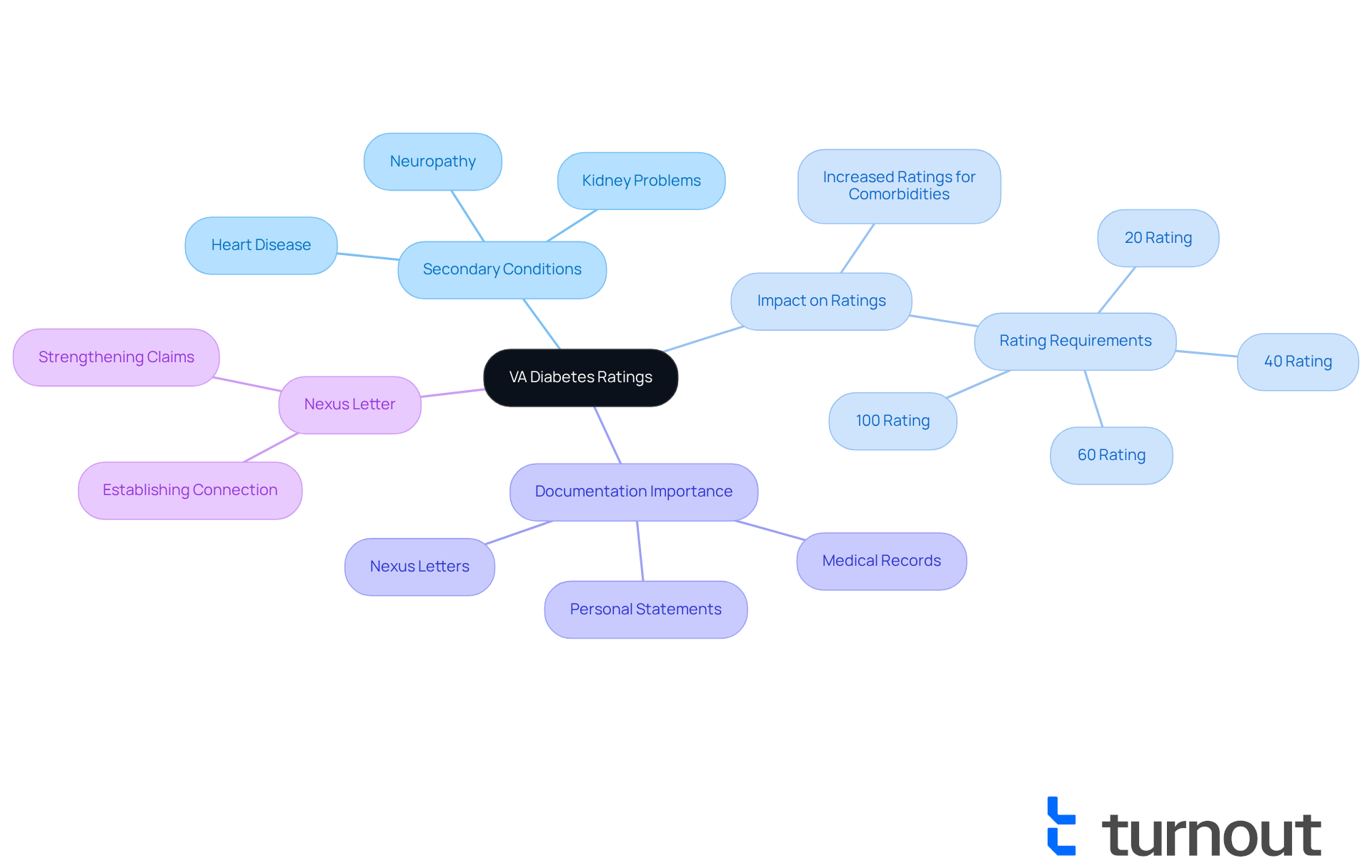
Agent Orange and Diabetes: Understanding the Connection
Veterans exposed to Agent Orange during their service may face a heightened risk of developing Type 2 health issues. We understand that this can be a daunting reality. The Department of Veterans Affairs (VA) recognizes this connection and offers a presumption of service connection for individuals diagnosed with a blood sugar condition, which is important for their VA rating for diabetes, who served in Vietnam or other specified regions. This assumption reduces the burden of evidence, allowing impacted service members to navigate the application process with greater ease.
Since the establishment of the NAS Institute of Medicine Committee in 1992, which reviewed the health effects of Agent Orange, the VA has upheld this presumption. Preliminary results released in 1994 highlighted the link between herbicide exposure and health problems, including blood sugar disorders. This ongoing acknowledgment has significantly improved the VA rating for diabetes for individuals affected by Agent Orange-related diabetes. Many individuals have successfully benefited from this policy, receiving the assistance they deserve without needing to establish a direct causal connection between their service and their condition.
Turnout is committed to making access to these essential benefits easier. We offer tools and services that assist former service members in managing the intricacies of the application process. Veterans have shared their experiences regarding the application process, emphasizing the relief that comes from the VA's recognition of their health issues as service-related. One veteran shared, "The VA's acknowledgment of my condition as connected to my service has significantly impacted my life." This recognition not only streamlines the process but also provides vital advantages that can greatly enhance their quality of life.
The ongoing efforts to support veterans with blood sugar issues related to Agent Orange exposure, including continuous reviews and studies conducted by the NAS and the VA, reflect a commitment to addressing the long-term health impacts of military service. Remember, you are not alone in this journey. We are here to help.
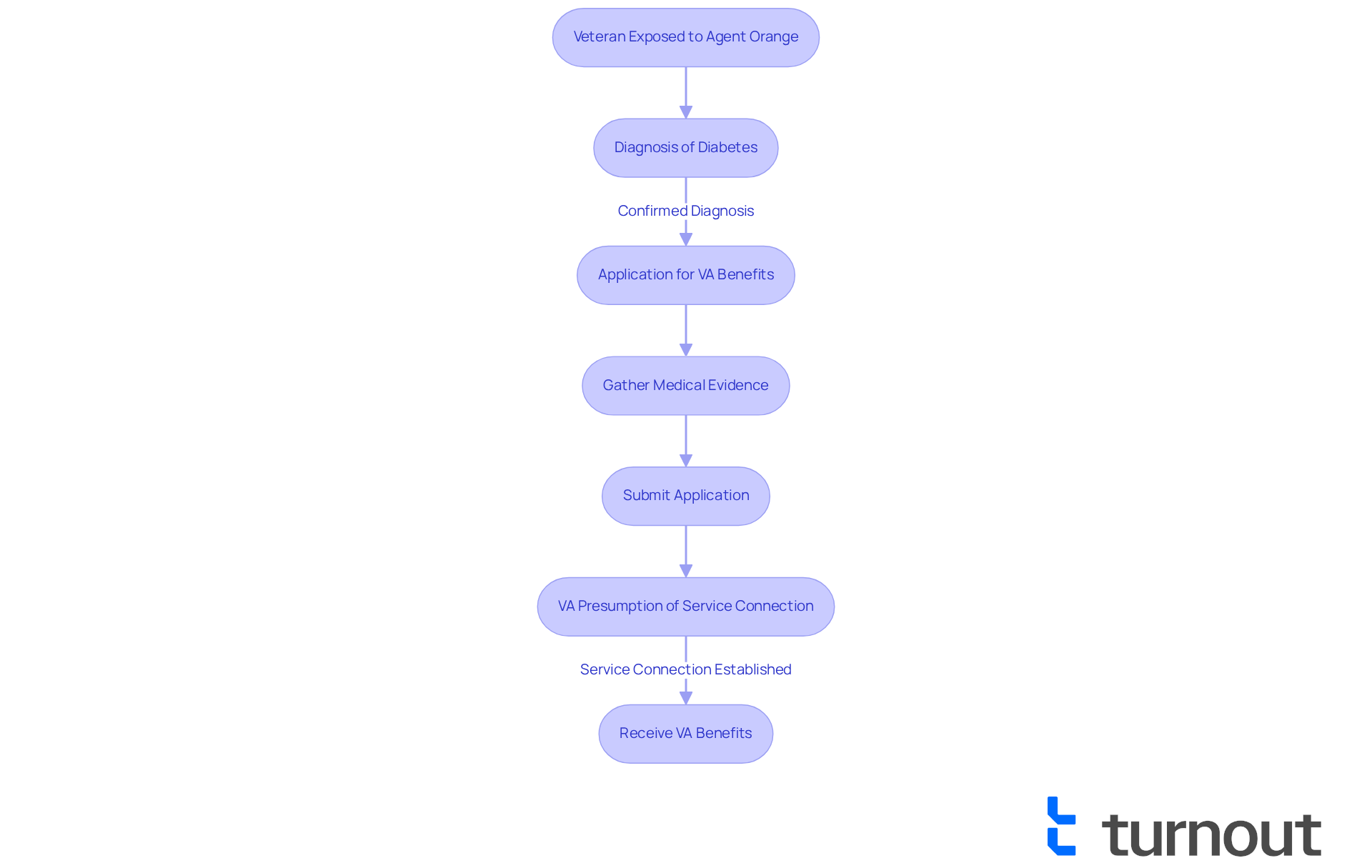
Steps to File a VA Claim for Diabetes Benefits
Filing a VA claim for diabetes benefits can feel overwhelming, but there are essential steps you can take to enhance your chances of success:
-
Gather Documentation: Start by collecting all relevant medical records, including documentation of your condition and any related complications. Strong evidence is crucial for a successful assertion. As an experienced supporter shares, 'Strong evidence is crucial for securing a va rating for diabetes, including service treatment records and formal diabetes diagnoses.'
-
Complete the Application: Next, fill out the VA Form 21-526EZ, which serves as your application for disability compensation. It’s important to ensure all sections are accurately completed to avoid delays.
-
Submit Your Request: You can submit your request online through the VA's website or via traditional mail. Online submissions tend to be processed more quickly, improving your chances of a timely response. The VA's website offers resources and assistance for submitting requests, making navigation through the process easier in 2025.
-
Attend Medical Examinations: Be prepared to attend any scheduled medical evaluations. These exams are critical for determining your va rating for diabetes. Approach them with thorough preparation, including tracking your blood glucose levels and medications.
-
Monitor Your Status: Regularly check the progress of your request through the VA's online portal. Remaining proactive can help you tackle any issues that arise during the handling of your request. Remember, you are encouraged to advocate for yourself and seek help from knowledgeable representatives.
-
Understand Appeal Options: If your request is denied, it’s important to be aware of the appeal options available to you, such as Supplemental Applications with new evidence, Higher-Level Reviews, and Board Appeals. This knowledge can be vital in managing the process successfully.
Many veterans who have simplified their application process emphasize the importance of comprehensive documentation and prompt follow-ups. For instance, one individual successfully navigated the system by ensuring all medical records were organized and maintaining consistent communication with VA representatives. This proactive approach not only accelerated his request but also led to a favorable outcome.
Additionally, utilizing the VA's online resources can significantly enhance your experience. By following these steps and leveraging available resources, you can improve your chances of securing the benefits you deserve. Remember, you are not alone in this journey, and we are here to help.
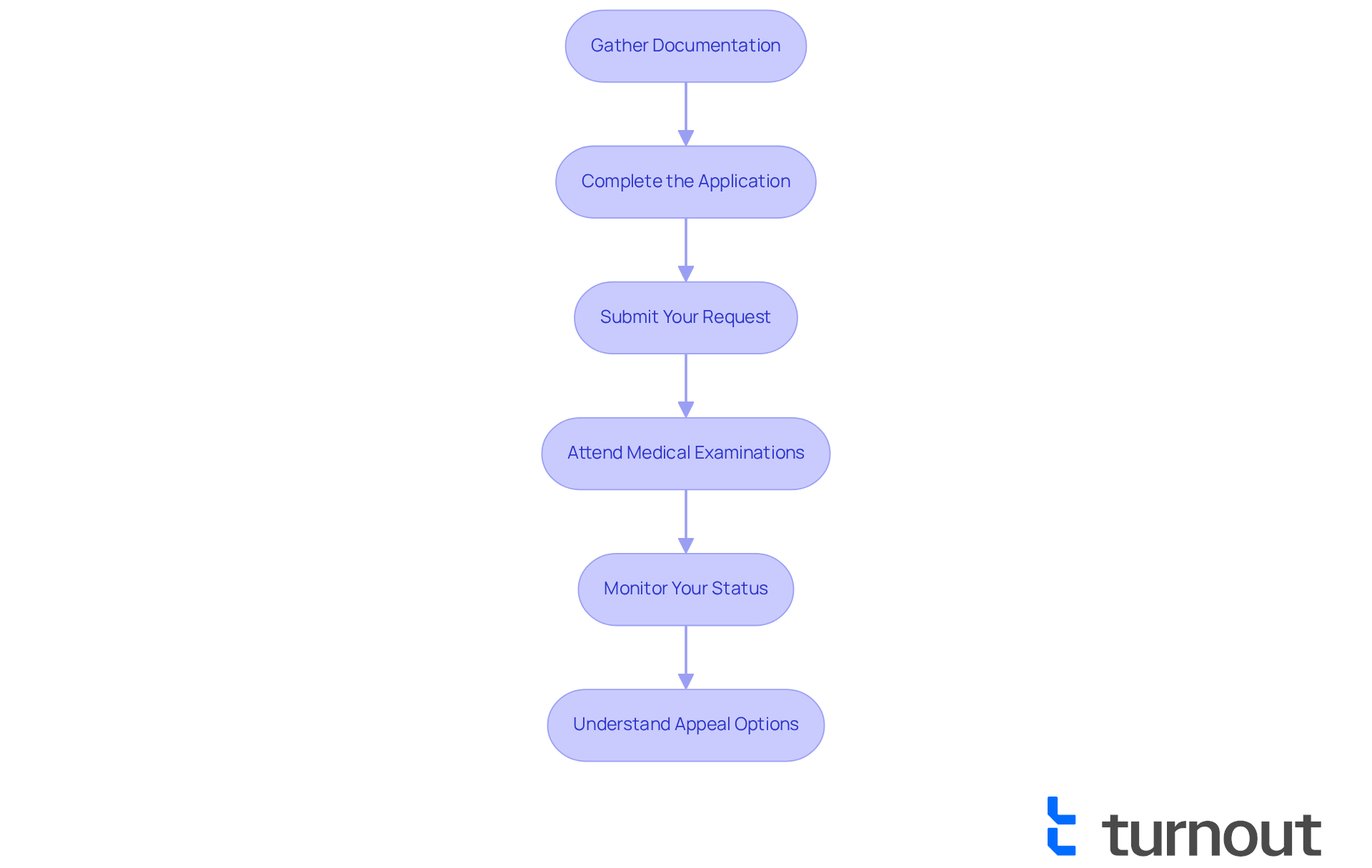
Essential Documentation for VA Diabetes Claims
When submitting a VA claim for health benefits, we understand that preparing and providing thorough documentation can feel overwhelming. However, having the right documents can significantly support your case. Here are the essential documents you should gather:
- Medical Records: Confirm your diagnosis of blood sugar issues with detailed medical records from both VA and private healthcare providers. This should include lab results and treatment history.
- Treatment Records: Include documentation of all treatments, medications, and therapies you have undergone for managing your condition.
- Evidence of Secondary Conditions: If you have any additional conditions associated with blood sugar issues, such as diabetic neuropathy or obstructive sleep apnea, collect medical documentation to back up these assertions. Remember, veterans can file claims for these secondary conditions, which can increase overall disability ratings.
- Service Records: If applicable, provide service records that demonstrate exposure to Agent Orange, which can establish a presumptive link to your condition.
- Nexus Letters: Acquire a nexus letter from a qualified medical professional to link your condition to military service or another service-related disability. This letter is essential for non-presumptive requests.
- Personal Statements: Write personal statements detailing how diabetes impacts your daily life, including any limitations you face and how the condition affects your overall well-being. A personal statement can humanize the medical data, making your argument more relatable.
Having these documents arranged and prepared can significantly improve the effectiveness of your application process. Research indicates that former service members who submit complete documentation experience higher approval rates; however, it's important to note that 75% of these individuals receive a VA rating for diabetes of 30% or lower, highlighting the challenges many face. One veteran shared, "The completeness of my documentation made all the difference in my approval process."
As we move into 2025, the VA continues to emphasize the importance of comprehensive evidence in the application process. Veterans are encouraged to keep their medical records current and to document their daily experiences with diabetes, as this can provide valuable context for their requests. Furthermore, the Compensation & Pension (C&P) examination is a crucial aspect of the VA disability application procedure, assessing the seriousness of conditions and their relation to military service. By ensuring that all necessary documentation is in place, you can improve your chances of receiving the benefits you deserve. Remember, you are not alone in this journey; we’re here to help.
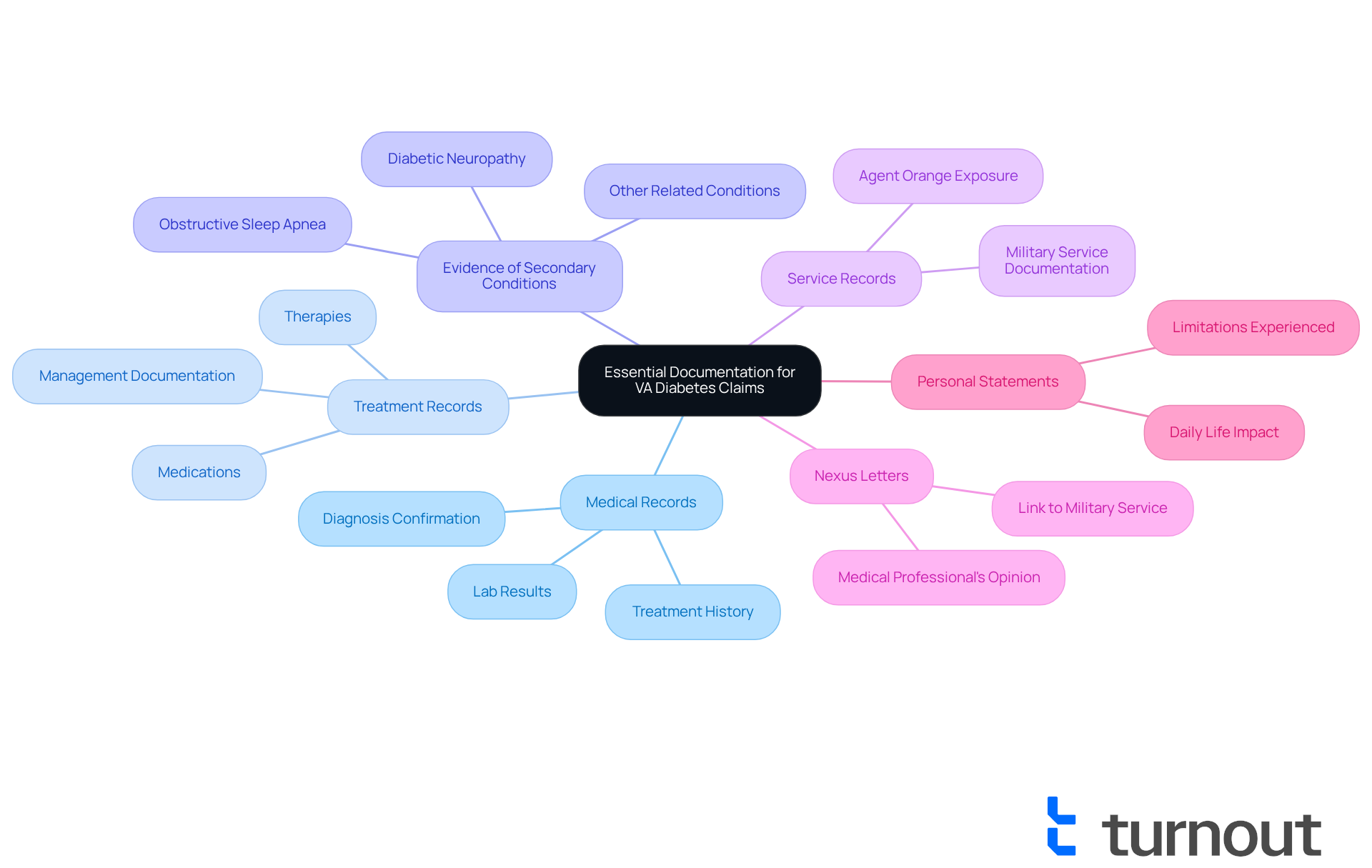
How the VA Evaluates Diabetes Claims: Key Factors
Navigating health-related requests with the VA can feel overwhelming, but understanding the process can make a significant difference. The VA assesses these requests based on several important factors, such as:
- The seriousness of your condition
- Any existing complications
- How it impacts your daily life
They carefully review medical records, treatment history, and any secondary conditions you may have.
We understand that this can be a lot to manage. Sometimes, the VA may even request a medical examination to evaluate your current blood sugar management as part of the VA rating for diabetes. Knowing these elements can empower former service members like you to present a stronger case for your requests.
Remember, you're not alone in this journey. We're here to help you navigate these challenges and ensure your voice is heard.
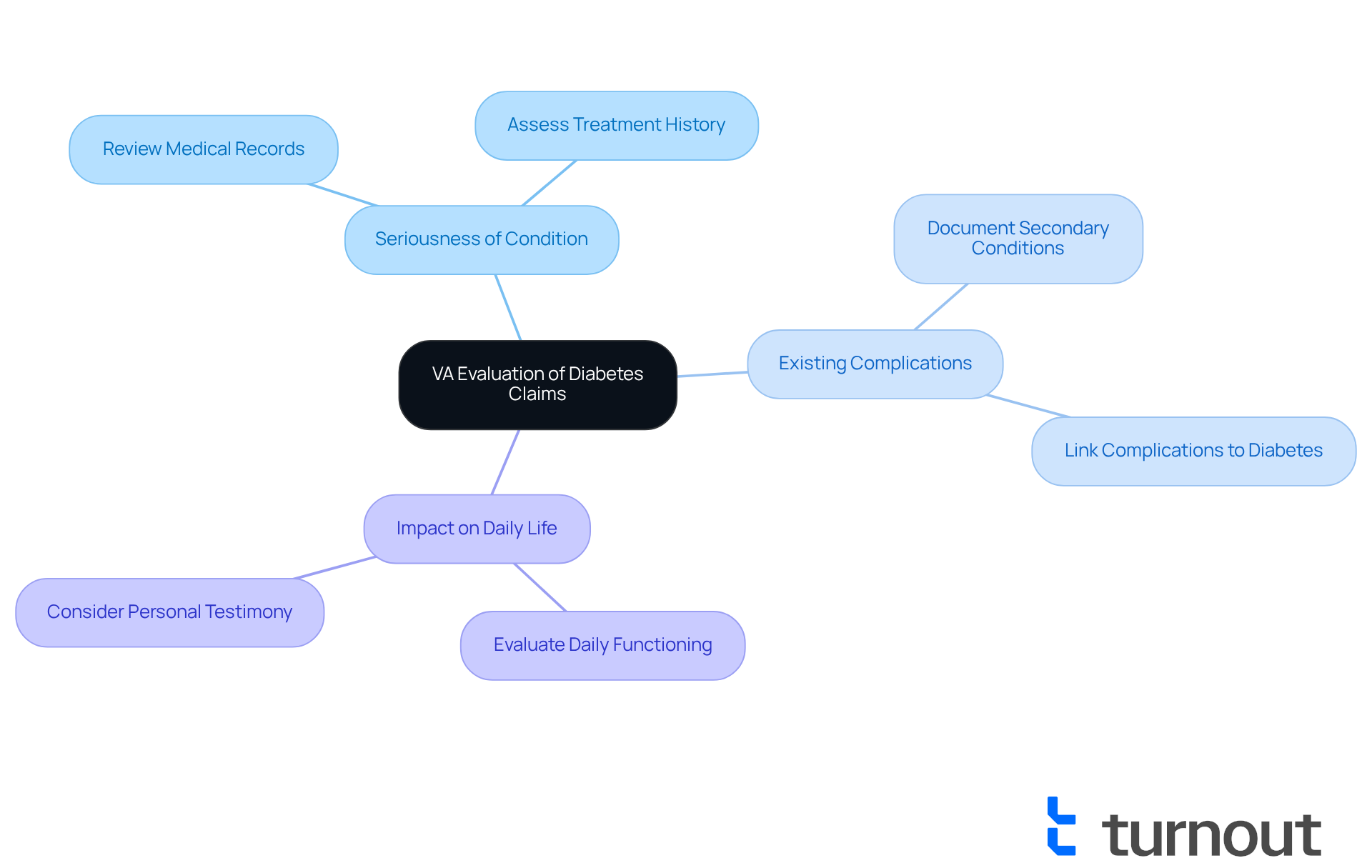
Navigating the Appeal Process for Denied VA Diabetes Claims
If your VA health condition request is denied, we understand how disheartening that can be. However, you possess the right to contest the decision, and we're here to help you through this process. The appeal process involves several key steps:
- Review the denial letter to understand the reasons for the denial. This is your first step toward clarity.
- Gather additional evidence or documentation that may support your case. High-quality medical evidence significantly enhances your chances of approval.
- File a Notice of Disagreement (NOD) with the VA to formally initiate your appeal. This step is crucial for keeping the process active.
- Attend any hearings or meetings as required. Here, you can present your case clearly and concisely.
- Remain organized and proactive during the process. It’s common to feel overwhelmed, especially as individuals with outstanding requests currently wait an average of 105 days for a decision, down from a peak of 282 days.
Persistence and thorough preparation can lead to a successful outcome. Many former service members have effectively contested their rejected health assertions by providing new and pertinent evidence, achieving a 41% acceptance rate in AMA Evidence Submissions. Engaging with support groups or resources can also provide valuable insights and assistance during this challenging journey. Remember, you are not alone in this process.
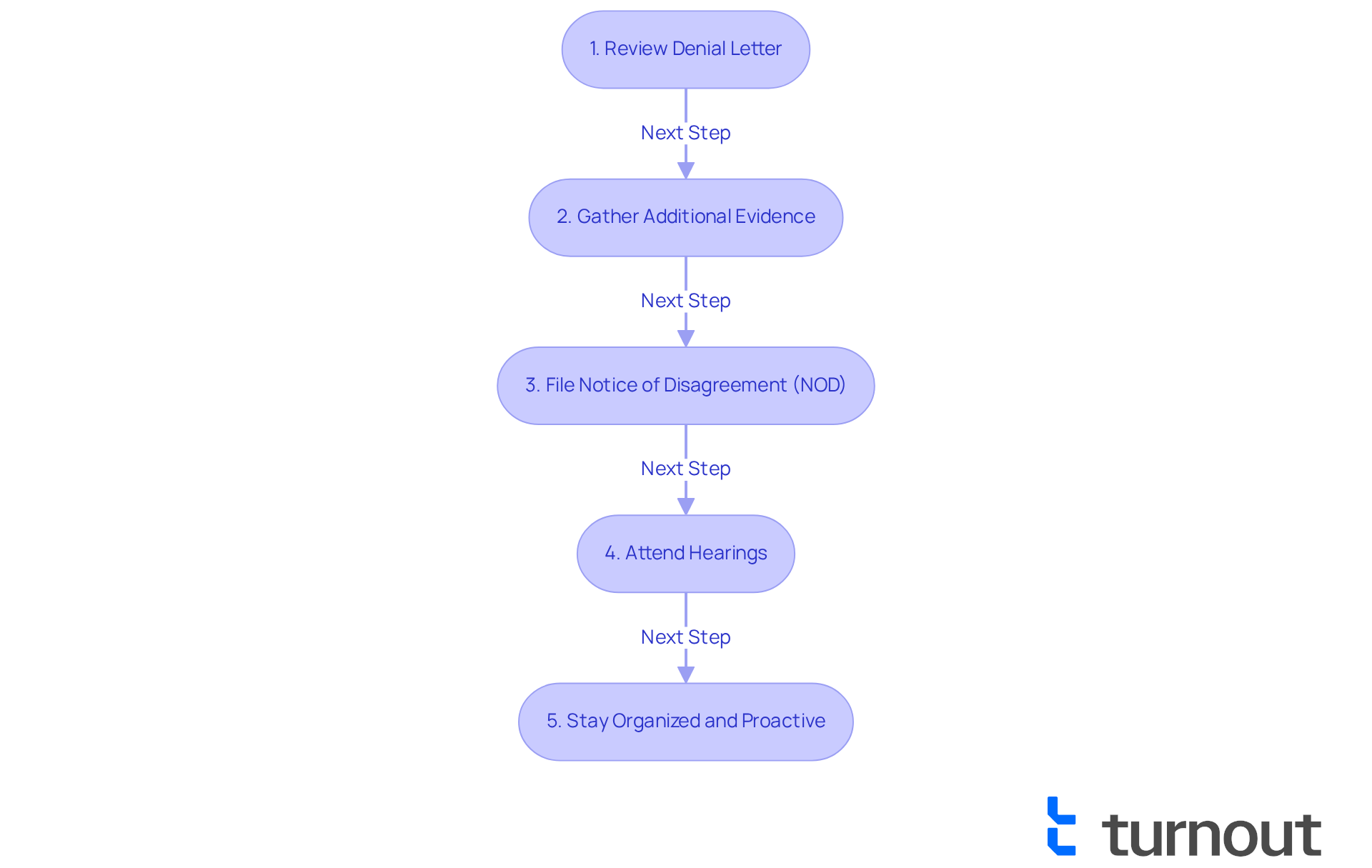
Recent Changes in VA Diabetes Rating Policies: What Veterans Need to Know
Recent updates to VA health assessment guidelines have introduced significant changes in how claims are evaluated, especially concerning secondary conditions and recognized risk factors. These modifications are crucial for former service members, as they can directly impact eligibility and assessments. For instance, if you are a veteran with Type 2 blood sugar issues, you may now find it easier to establish service connections, particularly if you have conditions linked to Agent Orange exposure. This shift highlights the importance of carefully documenting all health issues related to diabetes, including blood sugar levels and medication changes, which can enhance the VA rating for diabetes.
We understand that navigating these changes can be overwhelming. Veterans are encouraged to stay informed about these evolving guidelines, as they can significantly influence personal case results. Regularly checking the VA's official website or consulting with advocacy organizations can provide essential updates and insights. As Brian Reese, founder of VA Claims Insider, stated, "The PACT Act could be the key to unlocking the disability benefits you’ve rightfully earned for serving our country."
Many former service members have successfully adapted to these changes, utilizing the new policies to enhance their ratings and access benefits. The VA's commitment to recognizing the complexities of diabetes and its associated conditions highlights the need for a VA rating for diabetes to support veterans in their pursuit of rightful compensation. Additionally, it’s important to be aware of the appeals process for denied claims, which allows you to contest decisions and seek further review. Staying proactive and informed is key to maximizing the benefits available under these new guidelines.
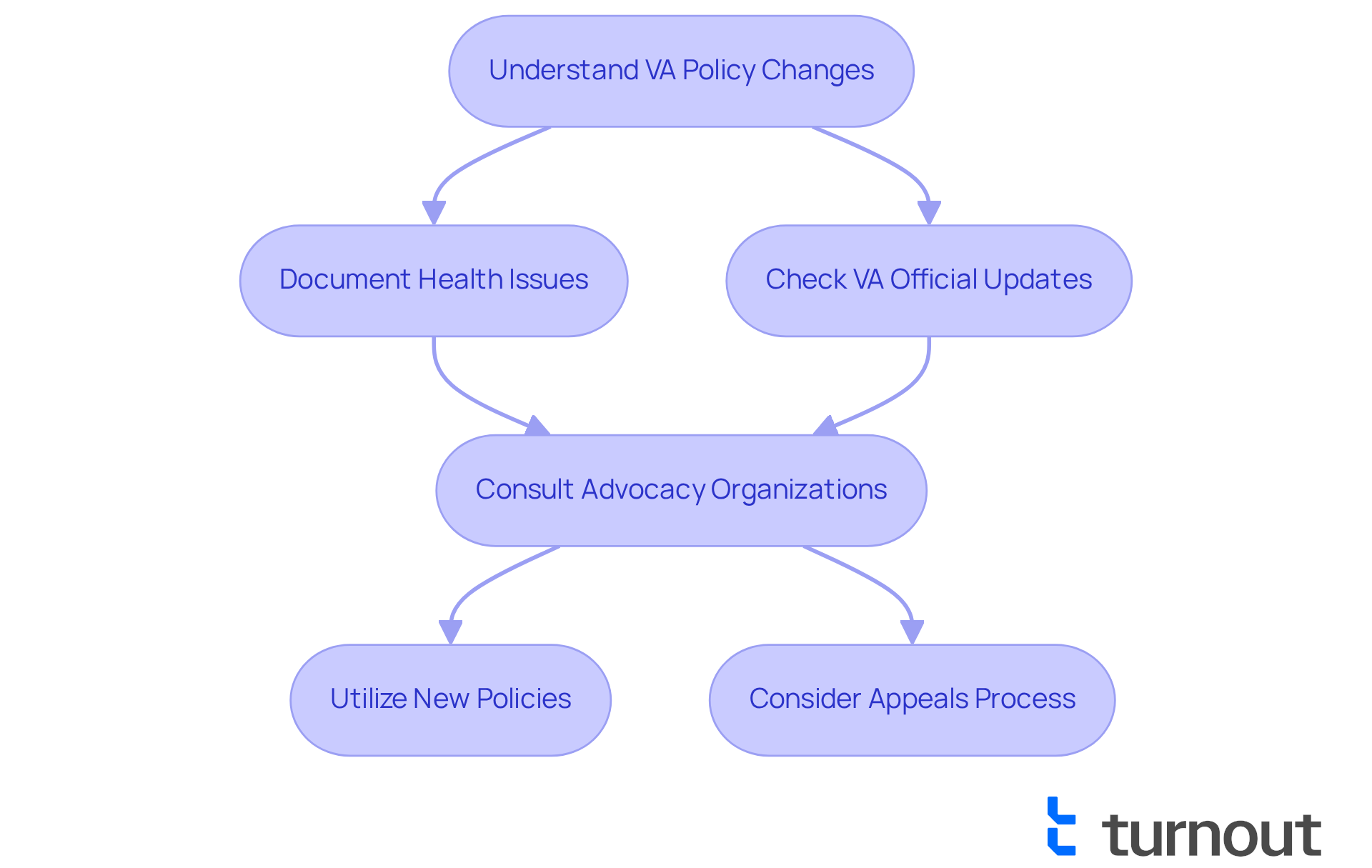
Conclusion
Navigating the VA rating for diabetes benefits can feel overwhelming. We understand that this journey is complex for many veterans. The insights shared throughout this article emphasize the importance of knowing the specific criteria, documentation requirements, and support systems that can help simplify this process. By leveraging resources like Turnout and understanding the differences between Type 1 and Type 2 diabetes, veterans can empower themselves to advocate for the benefits they deserve.
Key points discussed include:
- The significance of accurate documentation
- The impact of secondary conditions on VA ratings
- The essential steps to file a claim
- The connection between Agent Orange exposure and diabetes, as this can ease the claims process for many veterans
- Understanding the recent changes in VA policies is vital for maximizing benefits and ensuring that individual circumstances are considered
Ultimately, securing VA diabetes benefits is a journey that veterans do not have to undertake alone. By staying informed, organized, and proactive, former service members can navigate the complexities of the VA system with greater ease. Seeking assistance from knowledgeable advocates and utilizing available resources can significantly enhance the likelihood of a successful outcome. Remember, support is available, and taking that first step can lead to the benefits that honor the sacrifices made in service to our country.
Frequently Asked Questions
What is Turnout and how does it assist veterans with diabetes rating processes?
Turnout is an organization that utilizes AI technology to simplify the VA rating process for diabetes, making applications and claims easier for former service members. It provides timely support and guidance, helping veterans navigate the often daunting VA system.
What types of diabetes are recognized by the VA?
The VA recognizes two primary types of diabetes: Type 1 and Type 2. Type 1 is typically diagnosed in childhood and occurs when the body cannot produce insulin, while Type 2 is more common in adults and often arises from lifestyle factors.
How does exposure to Agent Orange affect Type 2 diabetes claims for veterans?
Veterans exposed to Agent Orange may qualify for benefits related to Type 2 diabetes without needing to demonstrate a direct link between their condition and military service, due to a presumptive connection established by the VA.
What documentation is important for veterans submitting claims for diabetes?
Important documentation includes medical records, personal statements, and lab results, which are vital for validating claims and securing appropriate VA evaluations.
How are VA ratings for diabetes determined?
VA ratings for diabetes are determined by the severity of the condition and its complications, with evaluations ranging from 0% to 100%. Higher percentages reflect more severe impacts on daily functioning.
What does a 20% VA rating for diabetes indicate?
A 20% VA rating for diabetes is commonly given to individuals who require insulin or oral medication to manage their condition.
Why is it important for veterans to keep detailed medical records?
Keeping detailed medical records is important because a veteran's blood sugar assessment may change based on the deterioration of their condition or escalation of treatment needs, which can affect their VA rating.
What support does Turnout offer to veterans navigating the VA rating process?
Turnout offers compassionate and efficient assistance through trained advocates, helping veterans understand the VA rating process and empowering them to take charge of their benefits journey.




